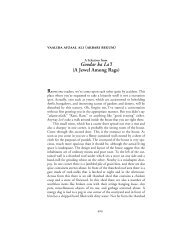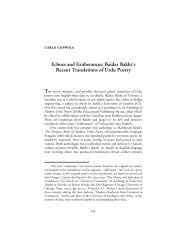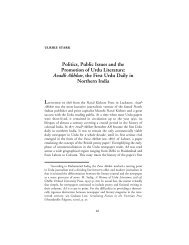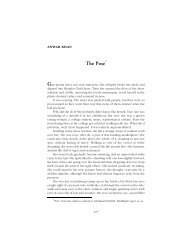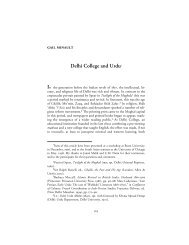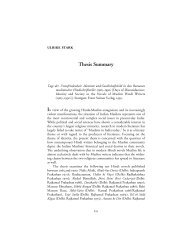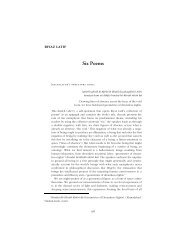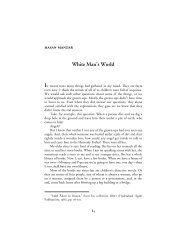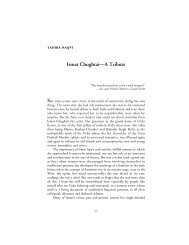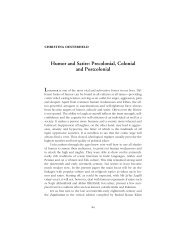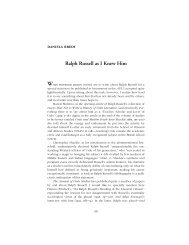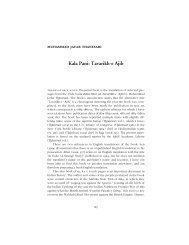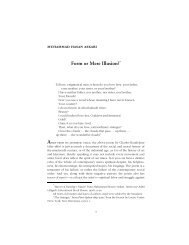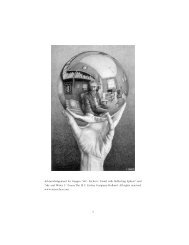Premchand's âShatranj ke Khilariâ in Translation - the Annual of Urdu ...
Premchand's âShatranj ke Khilariâ in Translation - the Annual of Urdu ...
Premchand's âShatranj ke Khilariâ in Translation - the Annual of Urdu ...
You also want an ePaper? Increase the reach of your titles
YUMPU automatically turns print PDFs into web optimized ePapers that Google loves.
198 • The <strong>Annual</strong> <strong>of</strong> <strong>Urdu</strong> Studies, No. 28<br />
translate are briefly reviewed. It <strong>the</strong>n conducts a close textual analysis <strong>of</strong><br />
Premchandís orig<strong>in</strong>al H<strong>in</strong>di story as well as his self-translated/transcreated<br />
ìSharanj kī Bāzīî <strong>in</strong> <strong>Urdu</strong> to analyze <strong>the</strong> ma<strong>in</strong> differentiat<strong>in</strong>g aspects which<br />
emphasize <strong>the</strong> politics <strong>of</strong> l<strong>in</strong>guistic and cultural representation. This is followed<br />
by focus<strong>in</strong>g on translational techniques/strategies <strong>in</strong> Rub<strong>in</strong>ís crosscultural<br />
translation ìThe Chess Players.î The study concludes with an estimation<br />
<strong>of</strong> Premchandís texts as depictive <strong>of</strong> <strong>the</strong> decadence <strong>of</strong> erstwhile<br />
Awadh.<br />
<strong>Translation</strong>al Tradition and Sociopolitical Culture<br />
<strong>Translation</strong> from <strong>the</strong> orig<strong>in</strong>al/source to <strong>the</strong> target/receptor language is a<br />
semiotic/<strong>in</strong>ter-semiotic exercise <strong>in</strong>volv<strong>in</strong>g, extr<strong>in</strong>sically, a change <strong>of</strong> script<br />
and, <strong>in</strong>tr<strong>in</strong>sically, a process <strong>of</strong> cultural, semantic and l<strong>in</strong>guistic decod<strong>in</strong>g<br />
and recod<strong>in</strong>g. It also <strong>in</strong>volves recension, abridgement, reorder<strong>in</strong>g, transcreation<br />
and adaptation. <strong>Translation</strong>al exercises are not new, but with<strong>in</strong><br />
subcont<strong>in</strong>ental India <strong>the</strong> n<strong>in</strong>eteenth century saw a surge <strong>in</strong> translational<br />
exercises which contributed significantly towards <strong>the</strong> development and<br />
standardization <strong>of</strong> both <strong>the</strong> dialectal l<strong>in</strong>guistic forms and <strong>the</strong> traditional<br />
literary genres <strong>of</strong>, especially, <strong>Urdu</strong> prose and fiction.<br />
Institutions such as Fort William College, Calcutta, (established 1800)<br />
and Delhi College (established ca. 1827) were set up as part <strong>of</strong> <strong>the</strong> colonial<br />
practice to dissem<strong>in</strong>ate knowledge <strong>of</strong> <strong>the</strong> Orient. <strong>Urdu</strong> was <strong>the</strong> mediat<strong>in</strong>g<br />
language at <strong>the</strong> Delhi College. <strong>Translation</strong>s underta<strong>ke</strong>n at <strong>the</strong>se <strong>in</strong>stitutions<br />
were osmotic <strong>in</strong> <strong>in</strong>fluenc<strong>in</strong>g <strong>the</strong> creation <strong>of</strong> modern <strong>Urdu</strong> literature and<br />
<strong>in</strong>strumental <strong>in</strong> cultivat<strong>in</strong>g a long stand<strong>in</strong>g <strong>in</strong>terest <strong>in</strong> <strong>Urdu</strong> prose. Besides<br />
Persian, Sanskrit, <strong>Urdu</strong> and H<strong>in</strong>di texts, <strong>the</strong> Naval Kishore Press, Lucknow<br />
(established 1858) also undertook translation <strong>of</strong> many English novels which<br />
were ìIndianizedî to accord with <strong>the</strong> Subcont<strong>in</strong>ental milieu. In <strong>the</strong> aftermath<br />
<strong>of</strong> <strong>the</strong> Upris<strong>in</strong>g <strong>of</strong> 1857, <strong>Urdu</strong> periodicals and papers became platforms<br />
for discursive, <strong>in</strong>tellectual, cultural and literary debates, <strong>the</strong>reby facilitat<strong>in</strong>g<br />
transactions between <strong>the</strong> East and <strong>the</strong> West. Thus Avadẖ Akhbār (1859),<br />
Avadẖ Panč (1877), and Tehẕībuíl-Akhlāq (1870) also published translations<br />
<strong>of</strong> European, especially English literature, provid<strong>in</strong>g new models for <strong>Urdu</strong><br />
writers. As aga<strong>in</strong>st <strong>the</strong> highly evolved poetic genres <strong>of</strong> <strong>Urdu</strong> literature, <strong>the</strong><br />
relatively younger prose forms <strong>of</strong> <strong>the</strong> <strong>Urdu</strong> afsāna (short story) and <strong>the</strong><br />
novel evolved from <strong>the</strong> conflation <strong>of</strong> several m<strong>in</strong>or and major <strong>in</strong>digenous<br />
genres, <strong>in</strong>flected with Western <strong>in</strong>fluence due to <strong>the</strong> various translational<br />
processes. The popularity <strong>of</strong> <strong>the</strong>se relatively new genres led to <strong>the</strong> absorption<br />
or gradual fad<strong>in</strong>g out <strong>of</strong> several older <strong>in</strong>digenous genres.



